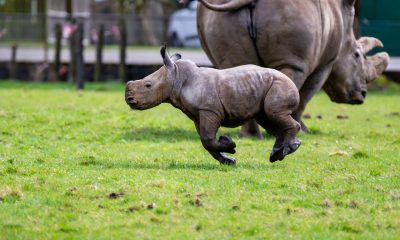Long lost ancestor of Dippy the Diplodocus unearthed in Greenland
It may have been the first sauropod to reach the northern hemisphere.
Published
2 years ago onBy
Talker News
By Mark Waghorn via SWNS
An ancient missing link to diplodocus - Britain's most famous dinosaur - has been unearthed in Greenland.
Dating back 214 million years, it fills a piece in the puzzle in the evolution of the biggest land creatures that ever lived.
The newly discovered plant eater was over 13 feet long, five feet tall and weighed up to a ton.

It has been named Issi saaneq, meaning 'cold bone' in the local Innuit language.
"Compared to the long-necked dinosaurs that came after, Issi would have been a very small animal," saidpaleontologist Victor Bennari.
"Some sauropods could reach over 80 feet in length and weigh more than 65 tons."
It was among the first members of a gigantic leaf eating group that includes diplodocus.
Dippy - a lifesize replica - has just returned to London's Natural History Museum after a nationwide tour.

"The sauropods evolved into the largest terrestrial animals of all time," said Bennari, a PhD student at the University of Nova, Lisbon
Argentinosaurus spanned up to 131 feet and weighed over 70 tons. Diplodocus reached 85 feet and weighed 25 tons.
Long-necked Issi walked on its hind legs and had short forelimbs with strong, grasping hands. It snacked on lakeside fern and palm leaves.
It was around during the Late Triassic as the supercontinent Pangaea broke up and the Atlantic Ocean began to form.
"It is hard to tell the direct ancestry of Diplodocus, but this animal would be a distant relative of Issi," Bennari said.
"Issi is an early sauropodomorph, and its relatives surely gave rise to Diplodocus and other large sauropods."
The beast was identified from two skulls dug up at a dinosaur graveyard at Jameson Land in East Greenland.
"They are unique in many aspects of their anatomy, such as their bone proportions and shapes," Bennari said.
"These specimens certainly pertain to a new species, Issi saaneq. It was a herbivore.
"It would have eaten leaves - probably ferns and gymnosperms such as cycads."
The skulls were originally thought to belong to iconic Plateosaurus - one of the first dinosaurs ever found.
But Bennari discovered dramatic differences during an analysis for his paleontology master's thesis.
"It is exciting to discover close relatives of the long-known Plateosaurus, of which more than one hundred individuals have been found here in Germany," said co-author Dr. Oliver Wings, from the Martin Luther University Halle-Wittenberg.
"Especially with such excellent preservation and two rather complete skulls."

Issi is described in the journal Diversity - some 25 years after the initial finds by scientists from Harvard University.
It may have been the first sauropod to reach the northern hemisphere. At the time, East Greenland was connected to what is now Europe.
"Back then, the Earth was going through climate changes that allowed for the first plant-eating dinosaurs to reach Europe and beyond," explainedproject co-ordinator Professor Lars Clemmensen, of the University of Copenhagen.
It was a transitional environment between the dry interior of Pangea, and the humid peripheral parts of the continent.
The fauna was diverse with large fishes, amphibians, ancient crocodiles, pterosaurs - and some of the first dinosaurs.
Vertebrate fossils have been collected since the 19th century - spanning from 400 million to 150 million years ago.
They include Ichtyostega, one of the first creatures to leave the oceans and step on land.
The skulls were from a juvnenile and sub-adult. They were analyzed using micro-CT (computed tomography) scans and the images segmented.
This enabled visualization of internal structures and bones still covered by sediment.

The international team also created 3D models that are available for download on the website MorphoSource.
Digitization also made it possible for Bennari to work during Covid lockdowns.
His supervisor Professor Octavio Mateus said: "This is the third new vertebrate fossil species that our team named for Greenland, which shows the scientific importance of that territory.
"It is spectacular to have a thesis in our Master in Palaeontology at the Nova University of Lisbon with these results and quality."
The Greenland dinosaur differs from all other sauropods by a set of unique features.
But it also shows similarities with Brazilian dinosaurs, such as Macrocollum and Unaysaurus - which are almost 15 million years older.
Together with the European Plateosaurus, they are known as plateosaurid sauropodomorphs.
They were bipedal and gracile animals, reaching 10 to 35 feet in length.

"The new dinosaur increases the diversity of dinosaurs during the Late Triassic (235-201 million years ago) and allows us to start retracing the evolutionary routes and timing for the iconic group of sauropods that roamed the Earth for almost 150 million years," added Bennari.
The skulls of Issi saaneq have gone on display at Lourinha Museum in Portugal.
Dippy - a 70 foot model - has had a starring role at the National History Museum since 1979.
It was cast from original fossil bones discovered in the US in 1898 - and has been on a road tour of Britain for the last three years.
Stories and infographics by ‘Talker Research’ are available to download & ready to use. Stories and videos by ‘Talker News’ are managed by SWNS. To license content for editorial or commercial use and to see the full scope of SWNS content, please email [email protected] or submit an inquiry via our contact form.
You may like


Metals can heal themselves just like ‘The Terminator’


Two-faced star has hydrogen on one side and helium on other


World’s oldest big game hunting weapon found


An espresso a day could keep Alzheimer’s at bay


Being bipolar significantly raises risk of premature death: study


Soccer players who regularly use head more likely to develop Alzheimer’s
Other Stories


Pro mermaid’s career goes swimmingly after overcoming ocean fear
She makes up to $8,000 a show.


Giant prehistoric salmon used tusk-like teeth to fight off predators
The species that grew up to nine feet long lived in the North American Pacific Northwest.


Evidence of Earth’s magnetic field dates back 3.7 billion years
Life on Earth would not be possible without its magnetic field.


Adorable video shows baby rhino enjoying sunshine
By Faye Mayern via SWNS An endangered baby rhino has well and truly found its feet after being filmed playing...


Hilarious moment delivery man gets chased by tiny dog
The hilarious encounter was caught on video.
Top Talkers

 Parenting7 days ago
Parenting7 days agoSingle mom details struggles of feeding her 12 kids

 Lifestyle6 days ago
Lifestyle6 days agoWoman regrets her tattoo nightmare: ‘It’s horrendous’

 Good News2 days ago
Good News2 days agoDisabled student takes first steps in 10 years on graduation stage

 Broadcast1 week ago
Broadcast1 week agoOver 40% of Americans have no clue what a 401k is

 Health3 days ago
Health3 days agoNew study reveals ‘old age’ begins later than it used to

 Broadcast1 week ago
Broadcast1 week agoHow hard is it for Americans to live sustainably?

 Money1 week ago
Money1 week agoOver 40% of Americans have no clue what a 401k is

 Wildlife2 days ago
Wildlife2 days agoClever elephant returns visitor’s shoe after falling into enclosure
